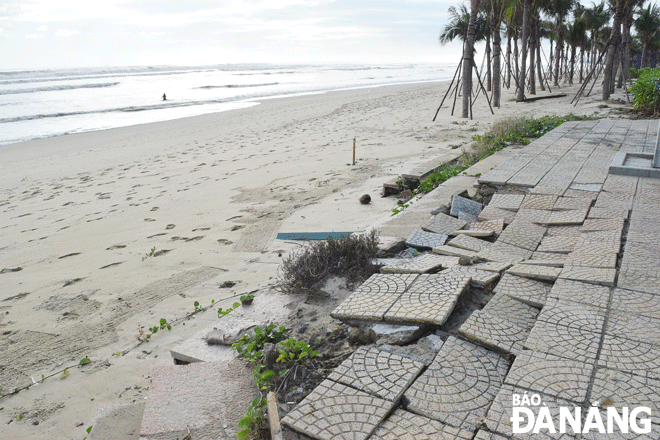Da Nang needs to enhance disaster preparedness for effective response
Unusual December Super Typhoon Rai proved that climate change has caused unpredictable extreme natural disasters. Da Nang was not greatly affected by this storm but this requires the city to develop strategies for adapting and building resilience to the impacts of a changing climate in a bid to protect the city’s growth and avoid unnecessary costs. Special attention must be given to investing in disaster resilient infrastructure to help reduce losses to life and property due to natural disasters.
 |
| Vo Nguyen Giap sidewalk embankment on the My An beach section in Ngu Hanh Son District was damaged after storm Rai. Photo: HOANG HIEP |
According to the Da Nang Steering Committee for Natural Disaster Prevention and Control, Da Nang has suffered from many different types of natural hazards over the past 20 years, bringing great damage, loss, destruction and devastation to life and property. Since 1998, natural disasters have left 219 people dead or missing, 226 injured, thousands of homes damaged, and urban and rural infrastructure heavily damaged with total economic losses of nearly VND 10,000 billion.
Over the past two decades, Da Nang has taken proactive action to develop specific disaster plans that have taken into account the peculiar conditions to be arisen due to the specific disaster like super typhoon, big floods, river floods and tsunamis. The municipal Department of Agriculture and Rural Development has already submitted a plan for natural disaster prevention and control for the 2021-2025 period for consideration and approval.
Adaptation, mitigation and disaster risk management are at the core of sustainable development. Hence, Da Nang is focusing on addressing climate change and disaster challenges to ensure sustainable development in line with the Prime Minister’s Decision No. 359 approving adjustments to the master plan of Da Nang by 2030 with a vision to 2045.
Mr Hoang Ngoc Tuan, the Director of the Central - Central Highlands Irrigation Science Institute stressed the need to invest in building disaster resilient infrastructure and upgrading the existing dykes and sea embankments that will be designed to cope with the strong winds, floods, and level 12 storms. The heed must be paid on investing in building a synchronous system of embankments to protect riverbanks and prevent floods in rivers in an attempt to strengthen the city’s efforts to reduce disaster risk and support the city’s sustainable development.
Besides, attention should be given to upgrading and expanding the capacity of storm shelters, ensuring the safety of construction works in urban areas, and strengthening coastal communities’ resilience before natural hazards, as well as developing plans to respond to natural disasters and emergency situations.
With a changing climate, Da Nang can expect more extreme weather. Hence, it is very necessary for the city to take proactive measures to lower the risk of damaging natural hazards, and reduce the impacts associated with these disasters.
Reporting by HOANG HIEP – translating by H.L